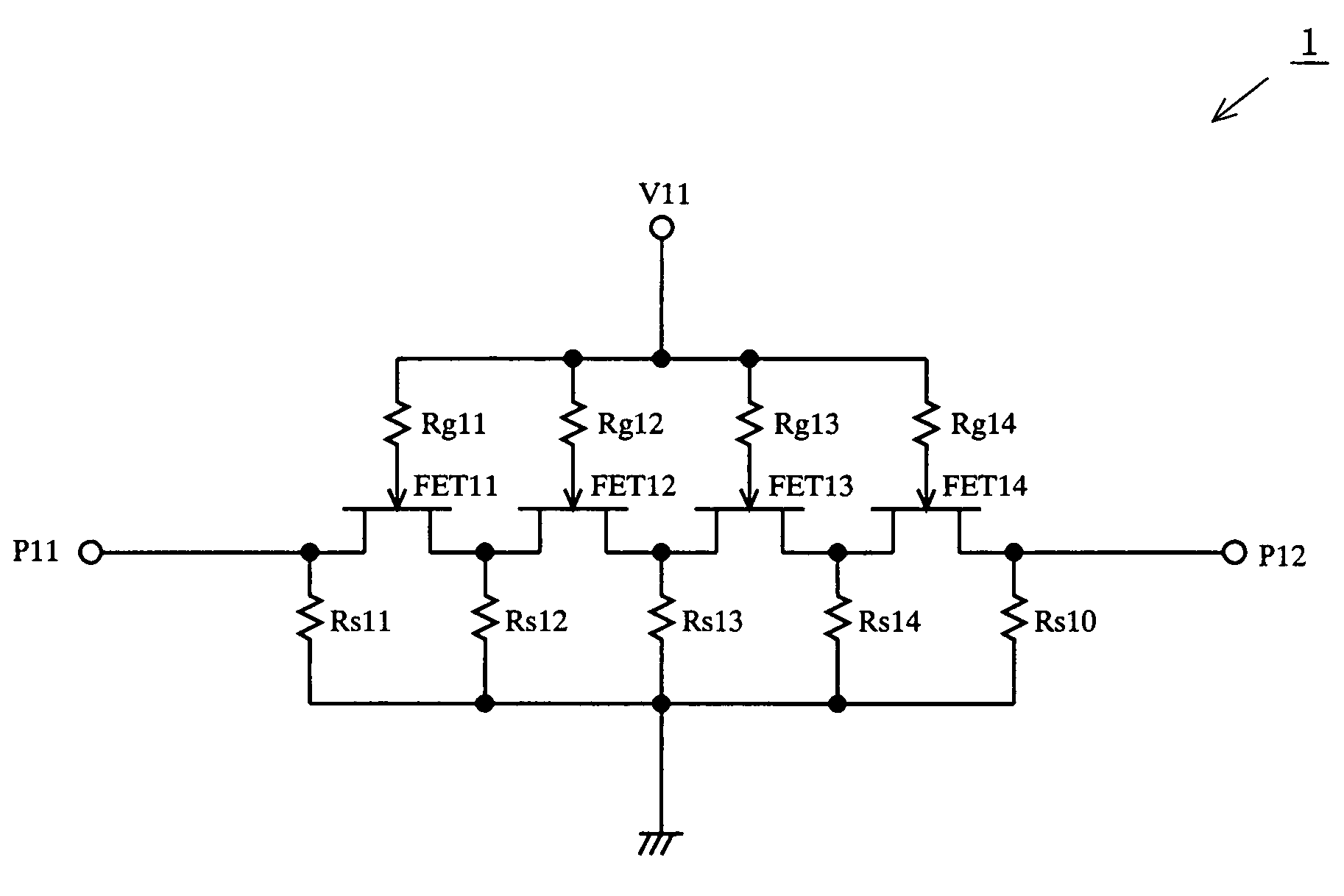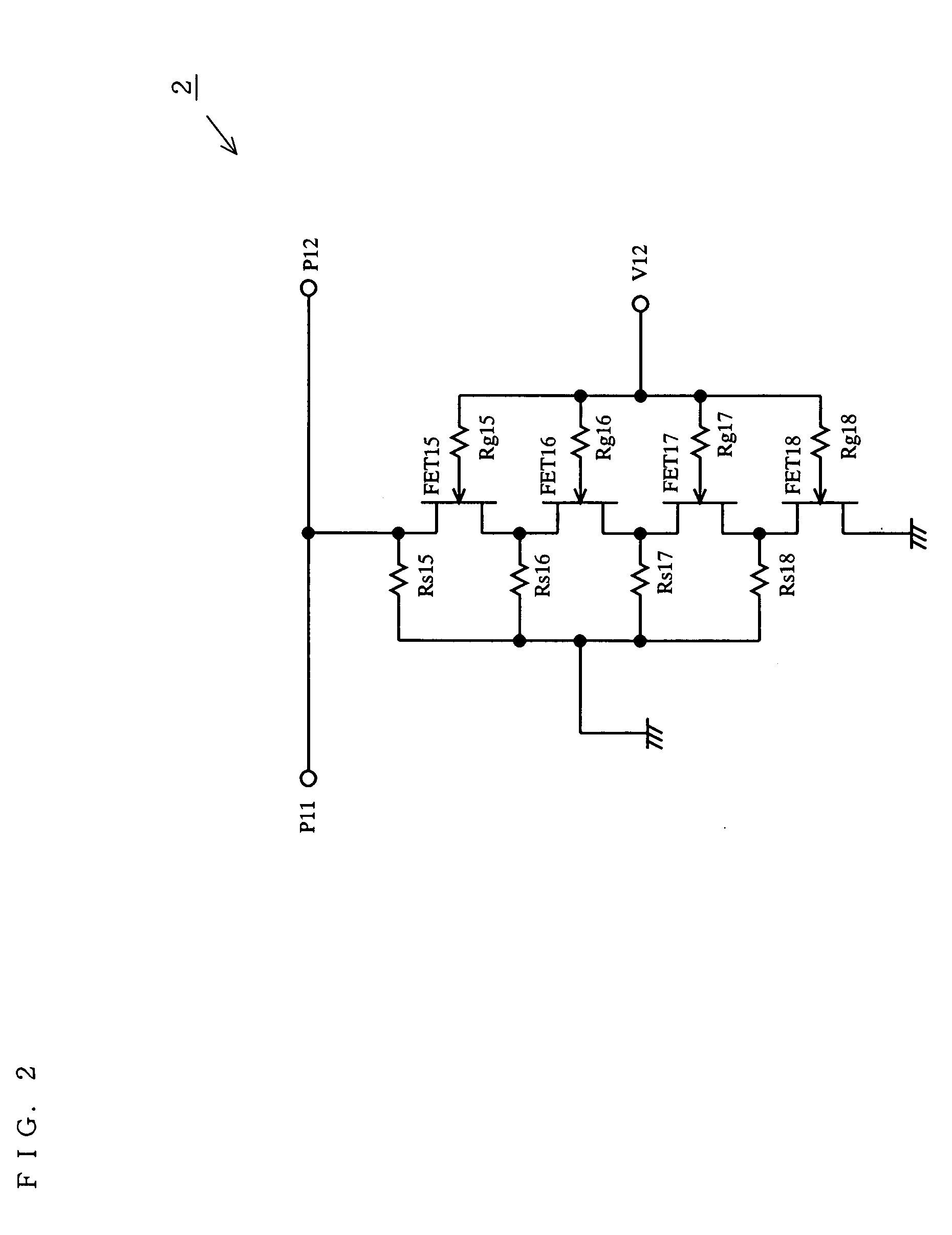Radio frequency switching circuit, radio frequency switching device, and transmitter module device
a radio frequency switching and radio frequency technology, applied in electronic switching, semiconductor devices, pulse techniques, etc., can solve the problems of difficult to overcome deterioration of radio frequency characteristics, and difficulty in overcoming the surge problems of radio frequency switching devices, etc., to achieve desirable radio frequency characteristics and endurance. desirable
- Summary
- Abstract
- Description
- Claims
- Application Information
AI Technical Summary
Benefits of technology
Problems solved by technology
Method used
Image
Examples
first embodiment
[0036]FIG. 1 shows a configuration of a radio frequency switching circuit 1 according to a first embodiment of the present invention. Referring to FIG. 1, the radio frequency switching circuit 1 includes FETs 11 to 14, and resistors Rg11 to Rg14 and Rs10 to Rs14. The FETs 11 to 14 may be depletion type metal-semiconductor field effect transistors (MES-FETs) whose primary material is gallium arsenide (GaAs), or metal-insulator-semiconductor field effect transistors (MIS-FETs) such as MOS-FETs.
[0037]The FETs 11 to 14 are connected together in series. The source of the FET 11 is connected to the first input / output terminal P11. The drain of the FET 14 is connected to the second input / output terminal P12. The sources and the drains of the FETs 11 to 14 are grounded via the resistors Rs10 to Rs14 each having a predetermined resistance value. The gates of the FETs 11 to 14 are connected to the control terminal V11 via the resistors Rg11 to Rg14, respectively. The first input / output termin...
second embodiment
[0044]FIG. 2 shows a configuration of a radio frequency switching circuit 2 according to a second embodiment of the present invention. Referring to FIG. 2, the radio frequency switching circuit 2 includes FETs 15 to 18, and resistors Rg15 to Rg18 and Rs15 to Rs18. The FETs 15 to 18 may be MES-FETs, MIS-FETs, or the like.
[0045]The FETs 15 to 18 are connected together in series. The source of the FET 15 is connected to the first input / output terminal P11 and the second input / output terminal P12. The drain of the FET 18 is grounded. The sources and the drains of the FETs 15 to 18 are grounded via the resistors Rs15 to Rs18, respectively, having a predetermined resistance value. The gates of the FETs 15 to 18 are connected to the control terminal V12 via the resistors Rg15 to Rg18, respectively. The first input / output terminal P11 and the second input / output terminal P12 are each connected to an external circuit such as an antenna circuit or a receiver circuit. A predetermined external ...
third embodiment
[0050]FIG. 3 shows a configuration of a radio frequency switching circuit 3 according to a third embodiment of the present invention. Referring to FIG. 3, the radio frequency switching circuit 3 includes FETs 11 to 18, and resistors Rg11 to Rg18 and Rs11 to Rs18. As can be seen from FIG. 3, the radio frequency switching circuit 3 of the third embodiment is a circuit obtained by combining the radio frequency switching circuit 1 of the first embodiment as a transfer circuit section with the radio frequency switching circuit 2 of the second embodiment as a shunt circuit. The resistor Rs10 is omitted since the resistor Rs15 serves as a shared resistor. It is understood that the number of FETs connected together in series in the transfer circuit section or the shunt circuit section.
[0051]Consider a case where an actuating voltage of 0V is applied to the control terminal V11, and a non-actuating voltage of −3V is applied to the control terminal V12. In such a case, each of the FETs (FETs ...
PUM
 Login to View More
Login to View More Abstract
Description
Claims
Application Information
 Login to View More
Login to View More - R&D
- Intellectual Property
- Life Sciences
- Materials
- Tech Scout
- Unparalleled Data Quality
- Higher Quality Content
- 60% Fewer Hallucinations
Browse by: Latest US Patents, China's latest patents, Technical Efficacy Thesaurus, Application Domain, Technology Topic, Popular Technical Reports.
© 2025 PatSnap. All rights reserved.Legal|Privacy policy|Modern Slavery Act Transparency Statement|Sitemap|About US| Contact US: help@patsnap.com



